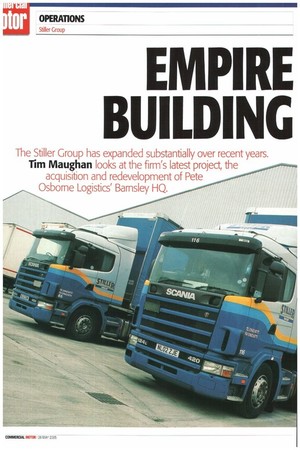EMPIRE BUILDING
Page 50

Page 51

Page 52

Page 53

If you've noticed an error in this article please click here to report it so we can fix it.
The Stiller Group has expanded substantially over recent years. Tim Maughan looks at the firm's latest project, the
acquisition and redevelopment of Pete Osborne Logistics' Barnsley HQ. The Stiller Group's base is in Stocktonon-Tees, but its 420-strong tractor fleet is dispersed across the country. From Bridgend to the Isle of Dogs, and from Bilston to Barnsley, Stiller trucks roll.This is a multifaceted company, with a fleet that includes curtainsiders, tankers, flats and steel coil carriers. It's also heavily involved in the warehousing and distribution business.
Over the past few years, the firm has expanded organically, but it's also been on the acquisition trail. In 2000, for example, it snapped up West Glamorgan-based steel operator Carline Transport.
David Mearns, general manager, business development, explains: 'ft was a nice fit with our own steel activities in the North-East." While Stiller has consolidated its existing markets, epitomised by the steel operations, this only accounts for half of its acquisitions.
Activity aids growth
Recent fleet additions include a dozen bulk powder tankers,which are based at Stockton. Mearns says:" We have also diversified into consumer items, such as haircare products."
Extra activity generates extra turnover, and in Stiller's case the growth has been startling. Annual turnover increased from £8.4m in 1994 to £20m in 1999, and .£66m in 2004.
In 2003 the company bought Pete Osborne L,ogistics.According to Mearns, the purchase of Osborne's site,in Darton, Barnsley, was the last part of the current development stage, enabling Stiller to offer complete nationwide coverage. -Our depot network has been developed to take on the WorkingTime Directive and as a response to customers' requirements," Mearns explains.
"Between 12 and 18 months ago we took a conscious decision to introduce a business development team to grow the business further. It's made up of six people. Pete Osborne Logistics was quite well known in this area, and the opportunity to purchase the business came alorig.We wanted to add more strings to our bow, so a dialogue began with the company," he adds. When the Stiller Group bought the firm, its Darton site had 14,000m2 of warehousing space. Now it's 35,000m2.
As we tour the site, the base contractors are re-roofing the warehouse.They operate from working platforms that hang, batlike, from the roof bearns.This makes it impossible for debris to fall on unwitting personnel below, and allows the warehouse to stay in use while the work is being carried out.
The building can hold 33,000 pallets."It's an ambient warehouse, so it can hold food," says Mearns,"but we also hold other items, from buckets, clothing and cleaning cloths through to haircare and beauty products. We're putting a new roof on the existing warehouse, plus two new chambers. We've invested somewhere in the region of f4.5m in this site."
Many truck operators have benefited from providing "added value" services, over and above straightforward road transport. Stiller Group personnel re-label TVs and VCRs at the Darton warehouse. Many household goods made in the Far East are labelled in the country in which they are sold.
Singular way forward
Many former Osborne Logistics personnel still work from the Darton site, but the Pete Osborne Logistics name and livery has gone. Some transport companies buy a firm and maintain its livery:the Welch Group is among recent examples (CM 13 January 2005). Others choose to absorb an acquisition. "One corporate identity is better for customers," believes Meams."I think sticking to one brand is the best way forward."
But MD Paul Stiller remarks: "Each business is different.You have to look at the merits of both." When the company acquired Sadler Tankers in 2000, it chose to keep the firm's name and livery "Sadler is well known in the chemical and petrochemical industry," Stiller points out.
Whatever form the group's acquisitions take in the future, Stiller is adamant storage accommodation will feature prominently. "Warehousing is extremely important to us. We see two main pillars to our service. We try to offer a complete supply chain solution— and that's difficult without a decent warehouse."
Alexander Brown, business director at the Darton site explains:"I focus on three main areas: the customer, the service and our employees. It is important that all three of these are well looked after."
He points out that a warehouse operation divides into three areas. Goods must be received; they must be stored and located; then they must be picked and dispatched. Traditionally, he says, this had entailed three different skills, but Stiller staff at this site have been trained to take on a multitude of warehouse duties, so one operative can perform a job "from beginning to end".
There are 45 warehouse personnel based at the Darton site, but when the situation demands staff can be drafted in from other Stiller Group bases.
Co-ordinated approach
Standardisation is important.The firm's computerised warehouse management system is the same at all locations.
This has obvious advantages in terms of maintenance. It also means staff working from a number of sites can understand one common package.
Project manager Paul Scattergood offers an overview of the software:"It's a really easy system to use, with drop-down menus. It takes two to three days to install the programme for a new contract; older systems would have taken two to three weeks.
"I can look at specific rank numbers on screen, and the graphs and so on are fully automated.The system updates itself every two minutes."At a click of the mouse, it will print off a batch of pallet labels, he adds.
Darton's location is also ideal Scattergood reveals, being one mile from the motorway and within easy reach of the Humber ports.
Stiller concludes: "We made a conscious decision to consolidate the industries we serve, in a robust way.We have also attracted more blue-chip customers." •












































































































































































































































